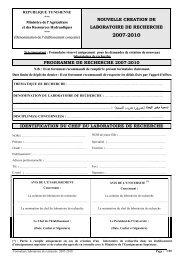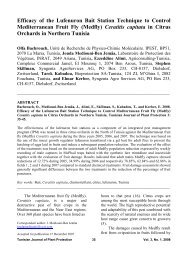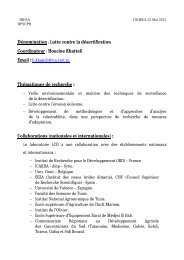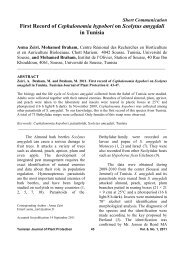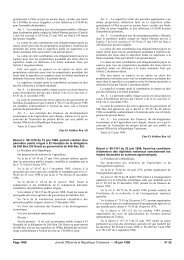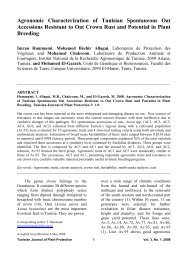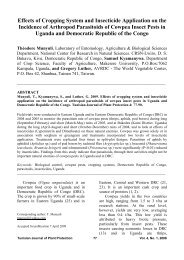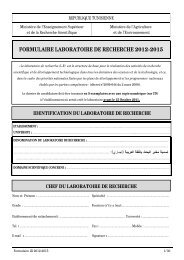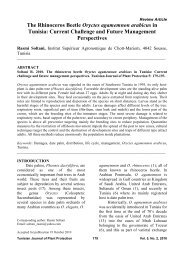Postharvest Control of the Date Moth Ectomyelois ceratoniae ... - Iresa
Postharvest Control of the Date Moth Ectomyelois ceratoniae ... - Iresa
Postharvest Control of the Date Moth Ectomyelois ceratoniae ... - Iresa
You also want an ePaper? Increase the reach of your titles
YUMPU automatically turns print PDFs into web optimized ePapers that Google loves.
stored dates and causes weight loss anddowngrading <strong>of</strong> <strong>the</strong> commercial value <strong>of</strong><strong>the</strong> fruit (2, 14).<strong>Date</strong>s intended for export undergo<strong>the</strong> process <strong>of</strong> conditioning to preserveand improve <strong>the</strong>ir quality. Chemicalcontrol using fumigation is <strong>the</strong> mosteconomical tool for managing this storedpest in postharvest treatment (3). Methylbromide is still <strong>the</strong> primary insecticide <strong>of</strong>postharvest insect control for dates inTunisia and in several o<strong>the</strong>r countries (19,53). Never<strong>the</strong>less, <strong>the</strong> use <strong>of</strong> thisfumigant is being restricted because <strong>of</strong> itshealth and environmental damages (6).Moreover, <strong>the</strong> Montreal Protocol <strong>of</strong> <strong>the</strong>United Nations Environment Program(49) recommends <strong>the</strong> phasing out <strong>of</strong>methyl bromide by 2005 in developedcountries and by 2015 in developingcountries (33).Consequently, research <strong>of</strong> effectivealternative methods is needed. In recentyears, essential oils have received muchattention as pest control agents because <strong>of</strong><strong>the</strong>ir insecticidal properties (42). Essentialoils are volatile and can act like fumigants<strong>of</strong>fering <strong>the</strong> prospect for use in storedproductprotection (7, 15, 41, 44, 46).Eucalyptus (Myrtaceae) is one <strong>of</strong> <strong>the</strong>most cultivated genera in <strong>the</strong> worldincluding more than 700 species. Variousbiological properties have already beenattributed to <strong>the</strong> genus Eucalyptus, among<strong>the</strong>m insecticidal activity against beetles(8), repellent action against Phlebotomuspapatasi (51) and larvicidal activity onculicids (10). Besides, eucalyptusessential oils are used for medicinal andpharmaceutical purposes (11, 12, 18, 26,37, 43). In Tunisia, 177 Eucalyptusspecies were introduced and acclimatizedinto more than 30 arboretums since 1957(23).The objectives <strong>of</strong> this study were todetermine <strong>the</strong> chemical composition <strong>of</strong><strong>the</strong> essential oils <strong>of</strong> Eucalyptuscamaldulensis and E. rudis and toevaluate <strong>the</strong>ir fumigant toxicity againstnew emerged adults <strong>of</strong> E. <strong>ceratoniae</strong>.MATERIALS AND METHODSInsect rearing. A laboratory rearingcolony was established in <strong>the</strong> Laboratory<strong>of</strong> Plant Protection at <strong>the</strong> Institut Nationalde la Recherche Agronomique de Tunisie(INRAT) from infested field-collecteddates. The moth was reared on anartificial diet based on wheat bran (60%),sucrose (12%), salt mixture (2%), yeast(1.3%), lysine (1.23%), methyl paraben(0.13%), vitamin C (0.67%), aureomycine(0.67%), glycerine (150 ml) and distilledwater (150 ml) (for details see 34).Rearing was conduced in plastic boxes(20 × 15 × 10 cm) placed in a rearingroom. The rearing conditions were:temperature <strong>of</strong> 25 ± 1°C, photoperiod <strong>of</strong>15: 9 (L: D) and 65 ± 5% relativehumidity.Plant material. E. camaldulensisand E. rudis leaves were collected fromnatural populations at <strong>the</strong> flowering stageon August 25, 2009 from <strong>the</strong> arboretum<strong>of</strong> Korbus (North Tunisia) <strong>of</strong> <strong>the</strong> InstitutNational des Recherches en GénieRurale, Eaux et Forêts (INRGREF). Theharvested material was air-dried at roomtemperature (20-25°C) for one week and<strong>the</strong>n stored in cloth bags.Essential oil extraction andanalysis. The essential oils wereextracted by hydrodistillation <strong>of</strong> driedplant material (100 g <strong>of</strong> each sample in500 ml <strong>of</strong> distilled water) using aClevenger-type apparatus for 4 h. The oilswere dried over anhydrous sodiumTunisian Journal <strong>of</strong> Plant Protection 202 Vol. 5, No. 2, 2010




